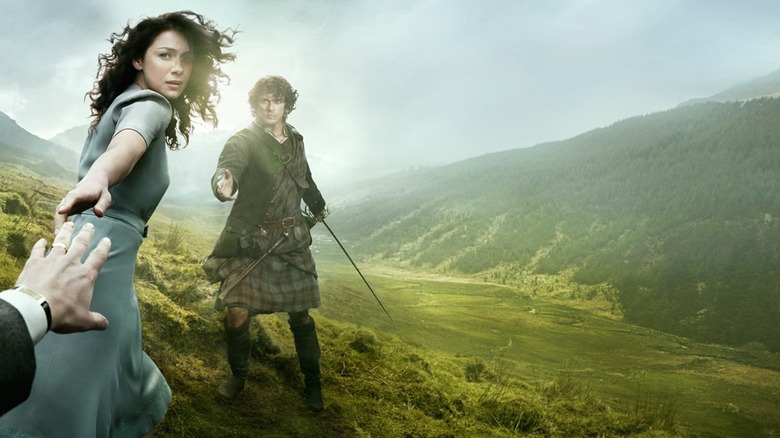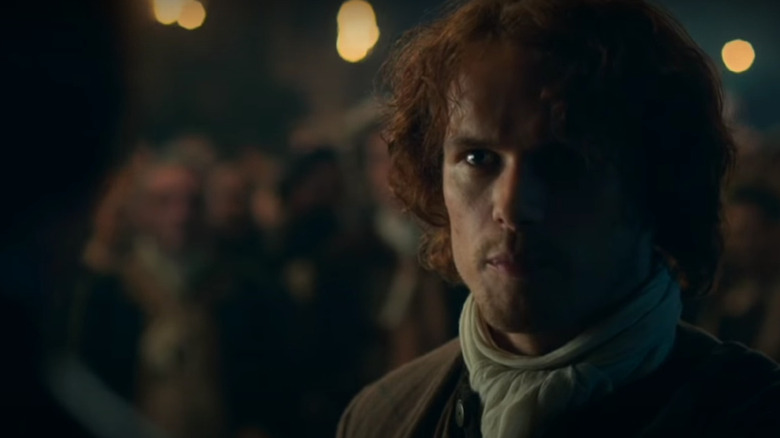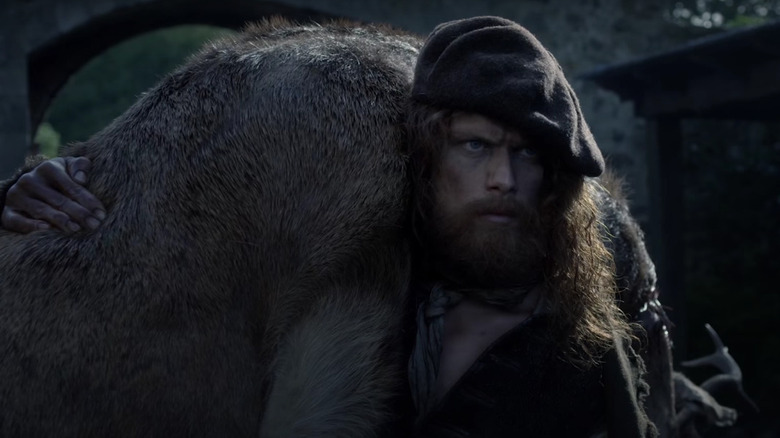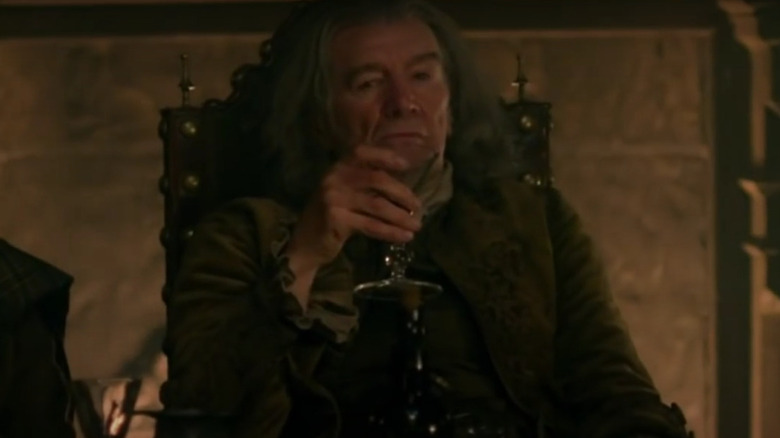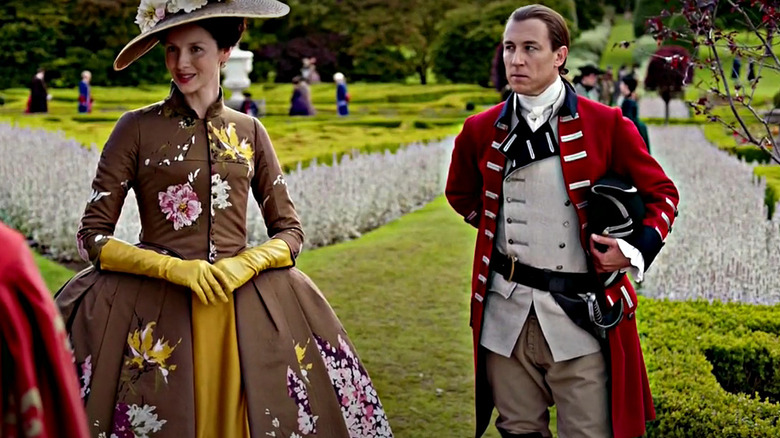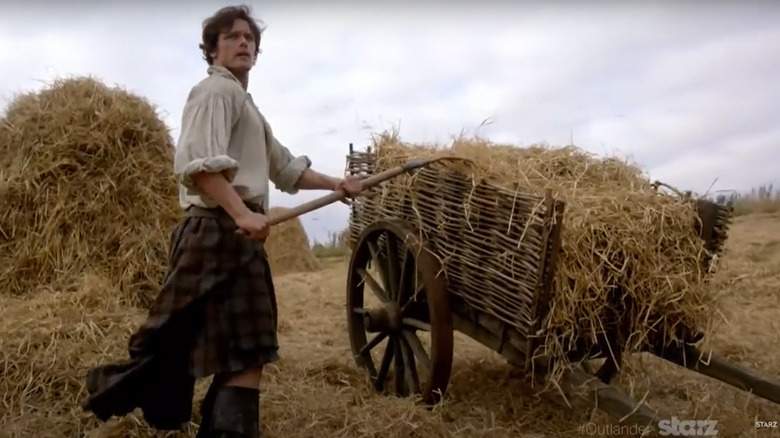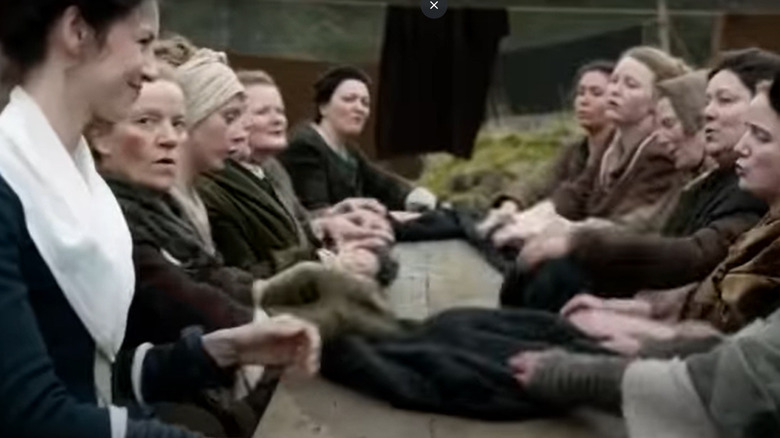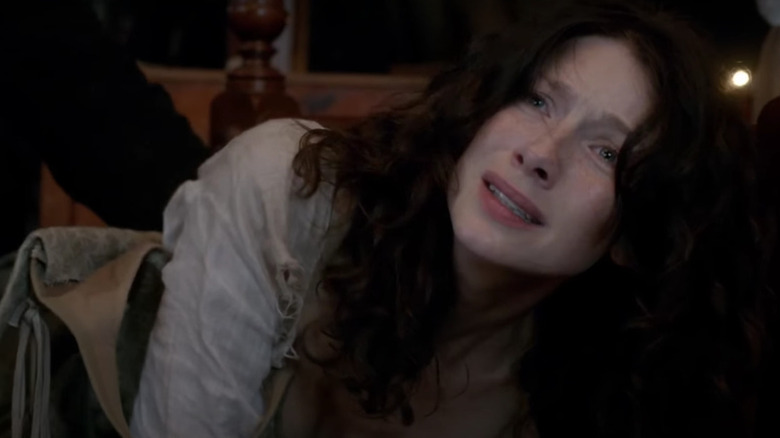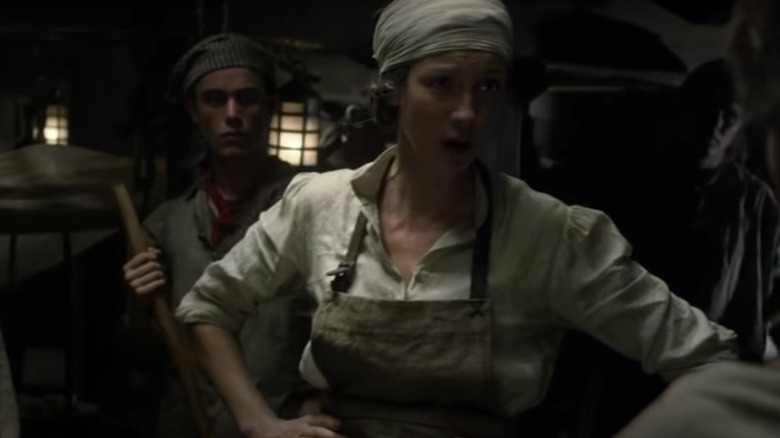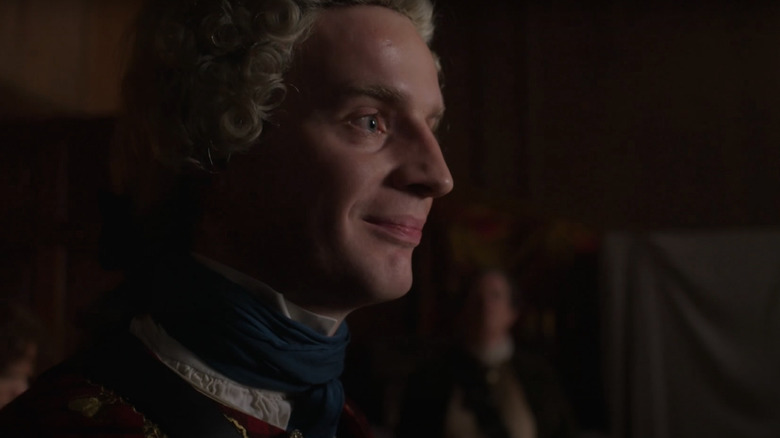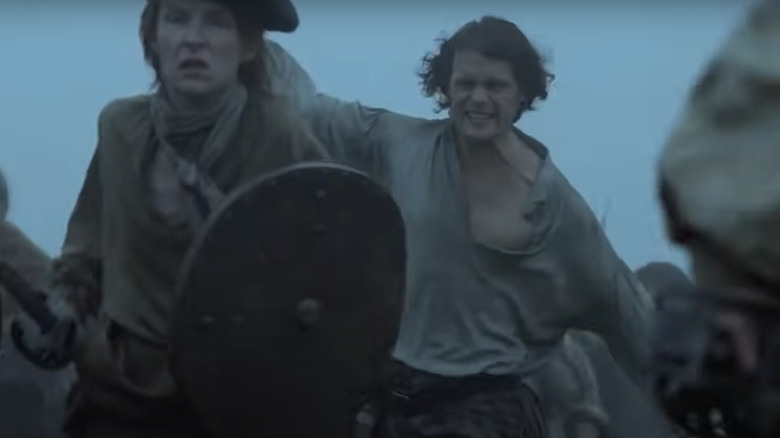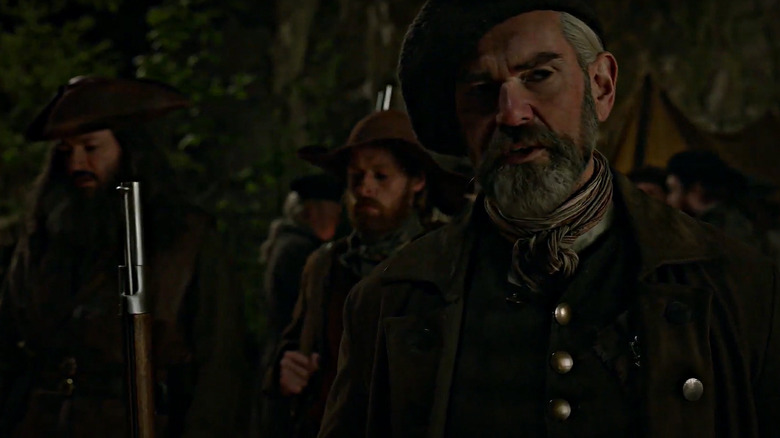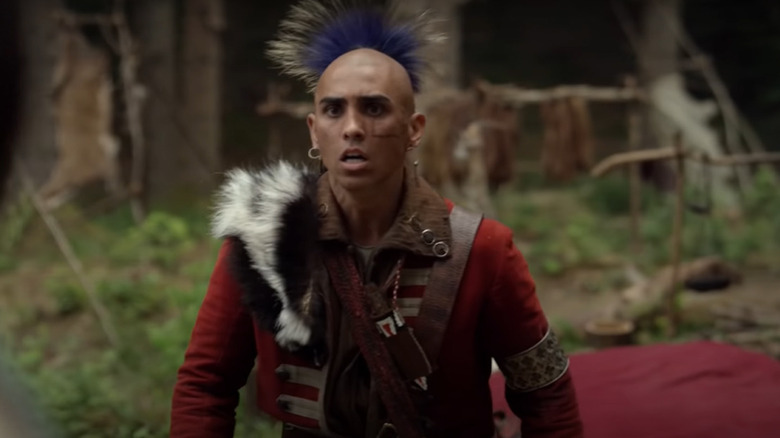Things Outlander Gets Right And Wrong About History
"Outlander," man. This show has it all, romance, steam, sexy accents, bloody battles, and kilts. Depending on which side of "historically accurate" you come down on, it's either a pleasure to watch or a guilty pleasure, but there's no way it's not at least some kind of pleasure, you know, unless you're completely dead on the inside. Yes, "Outlander" is good old-fashioned swashbuckling fun, if you can ignore the violent sexual assault and the icky portrayal of 18th-century colonial slavery.
The big question, though (apparently), is this: Is it accurate? Because every single period drama that's been made since people started to really relish being more right than everyone else absolutely must get every historical detail correct, or there will be pearl-clutching all across the great universities and historical societies of the world. Because the fact that the entire story is premised on a 20th-century woman time-traveling through a magical stone circle is totally cool, but god forbid if someone's kilt is the wrong color.
The author of the "Outlander" books (on which the show is based) told Parade that she goes to great lengths to try and get the details right. The showrunners, though ... eh. They do their best. They do take some liberties, but honestly, besides the pearl-clutchers in their dusty university libraries, who cares. Well, pearl-clutchers, this is for you. Here's what Outlander gets wrong, and everything it gets right, too.
Jamie Fraser was a real person! Sort of
So after you found out Jamie survived the battle of Culloden, you were like "yeah, right," mostly because showrunners spent the entirety of the first two seasons convincing you that if Jamie and Claire failed to stop the Jacobite rebellion, it would mean the bloody end of their romance and the next chapter in Claire's life with what's-his-name. Made extra sucky, of course, on account of what's-his-name looking exactly like arch-nemesis and all-around evil human Black Jack Randall. Never mind that everyone knew there was a third season coming, though to be fair George R.R. Martin pretty much destroyed the notion that lead characters never get killed off, so you never know.
Anyway, Jamie's survival isn't actually all that outlandish (har, har), especially when you consider that there was a real person who survived the battle of Culloden in much the same way as Jamie did. According to Parade, author Diana Gabaldon based Jamie's character on a Jacobite officer who survived the battle along with 18 other wounded Jacobite officers. Just like the fictional Jamie, the officer was called Fraser, and he narrowly escaped execution after he was discovered hiding in a farmhouse with the other men.
That's pretty much where the similarities end, though. Sadly, history does not remember how old or dashingly handsome the real Officer Fraser was, how sculpted his calves were, or whether he was married to a time-traveling World War II combat nurse. But hey, anything's possible.
The Dunbonnet was also a real person
After the battle of Culloden, Jamie hides in a cave, puts on some kind of weird floppy French beret thingy, and slowly transforms into the Dunbonnet, which is kind of somewhere between a Geico caveman and a bohemian folk musician. This, too, actually happened. According to Radio Times, the Dunbonnet was a Jacobite soldier who did hide out in a cave for seven lonely years following the Battle of Culloden. The locals fed him and named him after his hat so none of the local British troops would know what they were gossiping about. Though one does wonder why the local British troops wouldn't eventually go, "Hmm I wonder if this Dun Bonnet thing they keep talking about feeding is, like, a person or something?" Or maybe British soldiers in the 18th century really were all that stupid.
Anyway, not only was the Dunbonnet a real person, but they kind of sort of know where his cave was, or at least they know of a cave that could pass for the Dunbonnet's cave well enough that they can charge people admission to see it. Oh and also, the identity of the real Dunbonnet is known — he was the chief of the Fraser clan, and his name was Jamie Fraser. No kidding.
Jamie's grandfather Simon, Lord Lovat, was also real
The story includes some other real people, too, though liberties have been taken with things like relationships and who got along with whom. Jamie's grandfather in the show is Lord Lovat of the '45, also known as "the Old Fox," who in reality probably did not have a grandson named Jamie, but whatever. According to the Scotsman, the show did a pretty good job portraying Lord Lovat as history remembers him — as an over-the-top, self-serving rear end of a donkey. Just like in the show, the historical Lovat was loyal mostly to himself, so loyal that he sent his own son into the service of Charles Stuart and the Jacobites rather than putting himself in harm's way.
According to writer Catherine Curzon, the real "Old Fox" was executed by the British for his support of the Jacobite cause and was actually the last person to be publically executed in Britian, which makes sense because his execution did not go at all the way that the British wanted it to. For a start, Lord Lovat was not at all distressed or remorseful during his own execution, in fact, just before the executioner did his work, a huge crowd of onlookers tried to climb the scaffolding and it collapsed under their weight, killing 20 people and sending Lovat into fits of hysterical laughter. The accident didn't save him, but it might have made the British think twice about the wisdom of public executions.
What about the costumes?
Historical fiction doesn't always do the best job with costumes, mostly because modern viewers prefer costumes that are elaborate and, ahem, low-cut. Let's take for example the costumes in History's "Vikings," which were essentially a cross between leather biker wear and post-apocalyptic steampunk "Mad Max" something or other, though at least Lagertha wasn't tumbling out of her armored leather bikini during the Viking assault on the Anglo-Saxons or anything.
For the most part, the costume designs in "Outlander" are much more historically accurate, with a couple of notable exceptions. A lot of viewers have complained that Claire doesn't dress in a strictly 18th-century style, but that's by design. According to the Scotsman, in 18th-century Scotland, women wore embroidered dresses and tight corsets, and costume designers did stick to that baseline. Claire isn't an 18th-century woman, though, and since clothing in those days had to be tailored for each individual (Wal-Mart was still another couple of hundred years in the future) you wouldn't really expect Claire to adopt a strictly 18th-century style. Instead, her outfits are just a little quirky, just a bit modern, like the dressage gown from season two. Big, bold floral patterns weren't really a thing in 18th-century France (via Harper's Bazaar), but let's not forget that combat nurses from the mid-20th century weren't really a thing, either.
But the Fraser tartan is all wrong (maybe)
Just to sum up, clan colors are sort of like, Pepsi is blue and red, and Coke is white and red, and one had better not use the colors of the other or it'll come to blows — or possibly not, since Clan by Scotweb says it's all cool, you can totally wear any color tartan you want.
In fact, there's even some controversy about exactly how the whole tartan thing came to be and if it was even such a big deal in 18th-century Scotland. According to Elle, costume designer Terry Dresbach says she figured she'd be getting "angry letters" no matter what she did, so she just went down the kilt path that made the most sense to her. She chose to dress the Frasers in a dull, grayish tartan because she figured that brilliantly colored dyes were probably hard to come by in the damp, cold Scottish highlands, and may have even been too expensive for most ordinary Scots. She even thought this through to a granular level: She asked herself what dye-making materials would be easiest to obtain in that part of Scotland, and then designed everyone's kilts under the assumption that everyone in the neighborhood would have been using those dyes. In other words, shut your mouths pearl-clutchers. Not only is there method to the "Outlander" kilt madness, but it's kind of actually possible that the costume designers got it right and you're the one who's wrong.
The Gaelic is real, though
In Scotland in the 18th century, people probably wouldn't have spoken a lot of English. For a start, the language of the time was Scots Gaelic, and there really wouldn't have been any reason to speak any other language unless you were in the presence of people who couldn't speak Gaelic. Also, no one really liked the English, so the Scots wouldn't have lowered themselves to saying things like "pip pip" and "cheerio" if they didn't absolutely have to.
In the show, the Scots characters do speak Gaelic, but they don't seem to speak it a lot. This is both for Claire's benefit and for the audience's since there would have to be subtitles, and traditionally there's only so much subtitling that the average American can tolerate. Also, despite the fact there were plenty of Scottish actors on the show, only one actor knew more than a word or two of Gaelic, and ironically, it was the Sassenach herself (Catriona Balfe, who plays Claire). According to the Glasgow Times, everyone else had to take a five-week crash course in Gaelic led by a coach who did not let any of them get away with so much as an incorrect inflection. This means the Gaelic you hear on the show is accurate both in word and accent. And in case you're wondering, it's not subtitled because showrunners wanted the audience to experience Gaelic the way Claire does: like lovely but totally nonsensical linguistic music.
The witch trials were 20 years out of time
In the 11th episode of Season 1, Clare gets tried for witchcraft because, as everyone who has ever watched a period drama knows, in the Before Times women who had healing skills always got tried as witches. Thank you for saving my wife and newborn child! But how did you do that, you must be a witch! Kind of a tired trope to be honest, but whatever.
Anyway, it's the 1740s and Claire saves a boy from poisoning by doing what any 20th-century nurse would do — she gives him an antidote. This doesn't go over well with the village priest, who was trying to perform an exorcism on the poor kid, and it turns out to be the first couple of ice crystals in the "she's a witch!" snowball. Which makes for super exciting television, except for this one problem where witchcraft trials were totally not still a thing in the 1740s. In fact, writer Diana Gabaldon even told National Geographic that she was fully aware the last witch trial in Scotland happened 20 years before Claire's arrival, but because she really, really wanted Claire to face trial as a witch (fiction authors do live to make sure their protagonists are good and tormented) she went ahead and put one in the story anyway. Her reasoning: Who's to say that there wasn't a witch trial somewhere in Scotland that people just forgot to write down?
The medical stuff is pretty accurate
"Outlander" is so universally appealing (or maddening) that even the Journal of the Medical Library Association wanted to get in on the action, and in 2020 they published a whole paper (complete with a DOI!) entitled "Claire Fraser, RN, MD, OMG." See, scientists can sometimes have a sense of humor.
If you don't have a medical background, you've probably wondered just how accurate all the medical stuff is in the show. Does raw honey really work as an antibiotic ointment? Can you sterilize surgical tools with whiskey? Well, according to the author of the 2020 paper, not only are both of those things totally plausible, but so are most of the rest of Claire's 18th-century versions of 20th-century medicine. The one exception is the "penicillin" she makes out of Roquefort cheese. Although Roquefort does contain a mold that is related to penicillin, you couldn't use it to make actual penicillin. The author of the Journal of the Medical Library Association paper doesn't say how useful the resulting product might actually be, other than just noting that "it couldn't hurt."
Other critics have been less generous about the whole penicillin thing. Fansided, for example, commented that the way Claire was growing the mold was all wrong because it should have been done in the open air rather than under jars. Evidently, this is a detail that Diana Gabaldon raised with showrunners, but they went ahead and used jars anyway maybe because it just looked cooler.
Prince Charles probably wasn't anything like he was portrayed
Sure, he was called "Bonnie Prince Charlie," and everyone knows "Bonnie" is a girl's name (and also the word Scots use to complement feminine beauty), and therefore he must have been weak and ineffective, right? Now, let's just forget for a moment all the outdated stereotypes that exist in that assumption and note that the prince's reputation as a weakling originated in 18th-century propaganda, which is why you have to take most of history's remembrances about the personalities of monarchs with a grain of salt, especially when they're monarchs that ended up on the losing side.
The 1745 Association, which is a group of historians specifically interested in the Jacobite period, called the portrayal of the prince in "Outlander" "a hangover from the 18th century" (via The Scotsman). According to modern research, Prince Charles was an active participant in the Jacobite cause. He marched with his army over sometimes-difficult terrain and enjoyed broad support in Scotland, which would have been difficult to muster if he spent most of his time just sitting around looking "Bonnie."
On the other hand, it's true that Bonnie Prince Charlie wasn't a very effective leader. According to IGN, this was a hard pill for actor Sam Heughan (Jamie) to swallow since in Scotland, the prince is romanticized as a national hero. But the show could have portrayed this side of the prince without using the very outdated and offensive trope that effeminate equals ineffective.
Where are all the targes?
Everyone who's ever been to the movies knows what a genuine 18th-century battle looks like. Swords, armor, blood, and depending on how much detail the producers want to go into, decapitation, severed limbs, evisceration, people getting crushed by their horses, etc., etc. The bloodier the battle, the more accurate the audience tends to think it is. In fact, sometimes people get so caught up in all the gore that they forget there are other details that can lend authenticity to a battle scene, like what soldiers are wearing and what sorts of gear they're carrying.
According to Atholl Estates, the Scots used muskets at the Battle of Culloden, but they also used targes, and you only see a few of those in the battle as it's portrayed in "Outlander." Targes are shields that were carried by Scottish soldiers and would likely have been incredibly important for defending against British bayonets. In fact, the idea that some Scots would choose not to go into battle with both a weapon and a shield is a little strange, since it would be kind of like being in a car without a seatbelt or sunbathing without sunscreen, only, you know, much more immediately lethal.
It's unclear why showrunners chose not to outfit their Jacobite soldiers with targes, but it's probably at least safe to say that they were excluded for practical purposes, and showrunners just assumed (correctly) that most people weren't going to notice.
There really were a lot of Scots in the 18th-century Carolinas
In the show, Jamie and Claire eventually end up in 18th-century North Carolina. According to the National, both lowland and highland Scots really did settle in the area around Willmington and Cape Fear, North Carolina, during that time period. Some of them may have even been Jacobites, as evidenced by the fact that British loyalists accused the Scot governor of North Carolina of encouraging former Jacobites to move to the area.
In the fourth and fifth seasons of "Outlander," the audience is introduced to the Regulators, which you may remember from your American History classes (the ones you didn't sleep through) as the settlers who opposed British authority and over-taxation. In the show, one of their leaders is Murtagh Fraser, Jamie's godfather and former Jacobite. In reality, the Regulators were sometimes accused of being Jacobites but probably weren't — remember, in those days people liked to go around accusing people they didn't like of things that might get them executed, and that was mostly encouraged by anyone who stood to gain from that kind of behavior. Also, most of the Regulators were Scots-Irish, not highlanders.
Still, Scots did play a part in the American Revolution, but the National says that most of the Jacobites were probably fighting for the British — surprising, considering that those were the folks they'd fought against at Culloden.
The indigenous characters weren't exactly right
Almost no Hollywood production featuring white, colonial protagonists has managed to not screw up their portrayal of people of color. White characters become white saviors, and showrunners never seem willing to give non-white characters their own arcs, autonomy, and the ability to solve their own problems. "Outlander," sadly, is not an exception. In Season 4, we meet the Fraser's Indigenous neighbors, and stereotypes ensue. As far as accuracy goes, well, "Outlander" does get one thing right: European colonists showed up and took over native lands. Yeah, that happened.
Also, none of the actors playing Indigenous characters were Cherokee or Mohawk (the two groups depicted), though to be fair, that's hardly the fault of showrunners. According to Town and Country, actors' guild rules barred them from hiring Americans, and no one is as American as an Indigenous Americans. Happily, they were able to hire Canadian First Nation actors, so that's not so terrible. At least they were trying.
To their credit, they did also make an effort to get costumes right, although there's only so much they could have done given that not much was written down about what the Mohawks and the Cherokee were wearing back in the mid-1700s. So a lot of the Indigenous costumes you see on the show are based on guesswork, which means they're almost certainly not accurate. Or maybe they are; there's just no way to know for sure.
